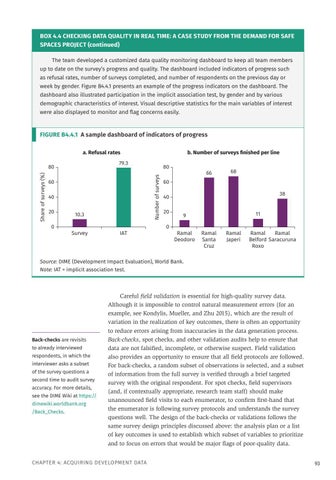BOX 4.4 CHECKING DATA QUALITY IN REAL TIME: A CASE STUDY FROM THE DEMAND FOR SAFE SPACES PROJECT (continued) The team developed a customized data quality monitoring dashboard to keep all team members up to date on the survey’s progress and quality. The dashboard included indicators of progress such as refusal rates, number of surveys completed, and number of respondents on the previous day or week by gender. Figure B4.4.1 presents an example of the progress indicators on the dashboard. The dashboard also illustrated participation in the implicit association test, by gender and by various demographic characteristics of interest. Visual descriptive statistics for the main variables of interest were also displayed to monitor and flag concerns easily.
FIGURE B4.4.1 A sample dashboard of indicators of progress a. Refusal rates 79.3
60 40
0
10.3 Survey
80 Number of surveys
Share of surveys (%)
80
20
b. Number of surveys finished per line
IAT
66
68
60 38
40 20 0
11
9 Ramal Deodoro
Ramal Santa Cruz
Ramal Japeri
Ramal Ramal Belford Saracuruna Roxo
Source: DIME (Development Impact Evaluation), World Bank. Note: IAT = implicit association test.
Back-checks are revisits to already interviewed respondents, in which the interviewer asks a subset of the survey questions a second time to audit survey accuracy. For more details, see the DIME Wiki at https:// dimewiki.worldbank.org /Back_Checks.
Careful field validation is essential for high-quality survey data. Although it is impossible to control natural measurement errors (for an example, see Kondylis, Mueller, and Zhu 2015), which are the result of variation in the realization of key outcomes, there is often an opportunity to reduce errors arising from inaccuracies in the data generation process. Back-checks, spot checks, and other validation audits help to ensure that data are not falsified, incomplete, or otherwise suspect. Field validation also provides an opportunity to ensure that all field protocols are followed. For back-checks, a random subset of observations is selected, and a subset of information from the full survey is verified through a brief targeted survey with the original respondent. For spot checks, field supervisors (and, if contextually appropriate, research team staff) should make unannounced field visits to each enumerator, to confirm first-hand that the enumerator is following survey protocols and understands the survey questions well. The design of the back-checks or validations follows the same survey design principles discussed above: the analysis plan or a list of key outcomes is used to establish which subset of variables to prioritize and to focus on errors that would be major flags of poor-quality data.
CHAPTER 4: ACQUIRING DEVELOPMENT DATA
93





